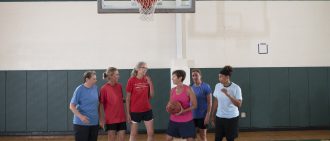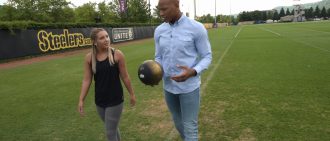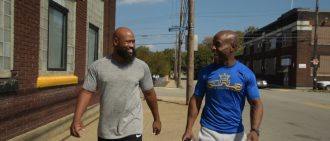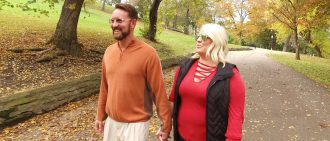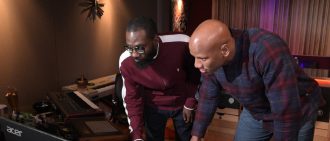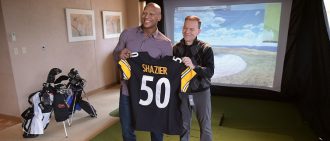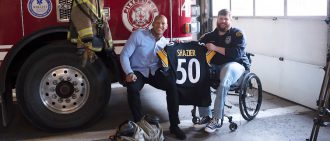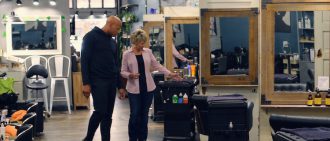A devastating car crash caused by a speeding driver running a red light left Paula Franetti with numerous severe injuries. Multiple surgical procedures and months of recovery time followed. But Paula remained determined to get back to her previously active lifestyle. She reached down deep to overcome every obstacle or setback that came up during her rehab, and she succeeded.
Find out more about Paula’s story in the premiere episode of Ryan Shazier’s 50 Phenoms podcast. Pittsburgh Steelers linebacker Ryan Shazier, who continues his own comeback from a spinal injury, joins Paula for a deeper conversation about their experiences. They discuss the adversity they both experienced, as well as the determination it took to overcome it.
Listen to more episodes of Ryan Shazier’s 50 Phenoms Podcast
Ryan Shazier's 50 Phenoms Season 1 Podcast
Read The Full Podcast Transcript
Announcer: Phenomenal courage, phenomenal stories. Next, on Ryan Shazier’s 50 Phenoms, turning trauma into triumph.
Paula Franetti: Well, on Sept. 13, 2016, a speeding driver ran through a red light and just brutally T-boned me on my driver’s-side door. And the impact was so hard that I literally thought I died.
Paula Franetti: I later learned that I had seven pelvic fractures, five spinal fractures, a ruptured diaphragm.
Announcer: In this premiere episode, Ryan Shazier talks to Paula Franetti, who suffered life-threatening injuries when a driver ran a red light going 50 miles an hour and slammed into the side of her car.
Ryan Shazier: It’s amazing to be able to know that you can play basketball again. With so many surgeries and having so many injuries and still being able to overcome it. So just to be able to go through all this is amazing.
Paula Franetti: You have to believe, right?
Announcer: Ryan uncovers the physical and mental challenges Paula faced after the crash and how she got back to living the life she loved.
Ryan Shazier: Yeah, so we’re in the basketball gym. Can you please let me know a little bit about why we’re in here?
Paula Franetti: Well, this is like my second home. Before my accident, I loved playing basketball and I played for the National Senior Games. I represent Pennsylvania as part of a team and never thought I was going to get to be back on the court again. But here I am, and it feels good. It feels good to be on the court again.
Ryan Shazier: Just hearing from your story, it’s amazing to be able to know that you can play basketball again. Me and you both have gone through some traumatic injuries and things that a lot of people haven’t had the opportunity to come back from. Can you please let me know a little bit about what happened in September?
Paula Franetti: Well, on Sept. 13, 2016, a speeding driver ran through a red light and just brutally T-boned me on my driver’s-side door. And the impact was so hard that I literally thought I died.
Ryan Shazier: Oh, man.
Paula Franetti: I went into this place and I wasn’t sure if I was alive or not, but from that accident I later learned that I had seven pelvic fractures, five spinal fractures, a ruptured diaphragm, a punctured bladder, internal bleeding, and a concussion. But it wasn’t a bleeding concussion, so luckily that didn’t happen.
Ryan Shazier: That’s a lot to overcome, just to be able to hear everything you’re saying at once. Some people can’t get over one, and you’re able to get over all this and be able to come back and play for the national team and play basketball, so that’s tremendous. I know dealing with a spinal cord injury, there’s a lot of adversity, a lot of trials, and a lot of people not rooting against you, but just don’t feel that you can make it to where I’m at now. So just to hear all of the things that you’ve overcome is amazing.
Paula Franetti: And I can relate to what you’re saying, Ryan, because there’s what you believe and what I believed, where I was going to get to. And people don’t know what it’s like to be in your own shoes.
Ryan Shazier: No, not at all.
Paula Franetti: And so they could tell you what they think and they’re going to believe what they think, but it has to come from within.
Ryan Shazier: Right.
Paula Franetti: You have to believe. Right?
Ryan Shazier: Yeah, the biggest thing is a lot of people always say, “Oh, I understand,” or, “I know what you’re going through.” And the thing is, a lot of people really don’t. A lot of people don’t understand what you’re going through, and can’t relate. What they’re going through compared to what we’re going through is just totally different. We might not be able to relate to what they’re going through, but being T-boned, and going through so many surgeries and having so many injuries, and still be able to overcome it. Just to be able to go through all this is amazing.
Paula Franetti: It is amazing. It’s lonely, though.
Ryan Shazier: Yeah, yeah.
Paula Franetti: I mean, don’t you find there’s times where, because no one understands, you really spend a lot of time with your own mind.
Ryan Shazier: You can definitely be in a dark place, a lonely place, or a scary place. And I actually wanted to ask you about that. When they told you about the recovery and how long it was going to be, what was your thoughts?
Paula Franetti: Quite shocking because I’m self-employed, right? And they were telling me, you weren’t going to be able to work at least for a year. And when you don’t work, you don’t get paid. Right? And I was 60 at the time, so here I am thinking, “I’m supposed to be getting closer to retirement, and now I have to start my whole life over again.” It’s like these negative thoughts, if you let them fester, they can take you to a really, really low place and make you think, “What’s going to happen to me?” or make you afraid. But somehow you find that that inner spirit, that inner motivation to to say, “No, I am going to start all over again, and I’m going to make it.”
Ryan Shazier: Yeah, definitely. People don’t understand being in a dark place, being in a lonely place, and just fighting through all the injuries that you’ve gone through, and you had one accident that caused so many injuries. And for me, I had one accident that caused one injury, but it was still very dangerous, very traumatic. A lot of times people, they feel that you should be able to get over something in a beat of a second. Or me and my dad always like to call it the roller coaster effect. A lot of people when they’re seeing a roller coaster, they’re like, “Man, this roller coaster is going fast.” But when you’re on the roller coaster and you’re feeling all the bumps and bruises in every turn, it feels like it’s a lot longer than it actually is. A lot of people don’t understand, don’t relate, and you can definitely get in a lonely place, even if you have people close to you.
Ryan Shazier: And I want to ask you, do you feel like your family and friends were a big part of your recovery?
Paula Franetti: Oh, absolutely. When this happened, I’m single and I don’t have children, and so I had to rely on family. My mom and dad had passed on, so I didn’t have an immediate family. My sister in Florida came up and stayed with me for a few weeks. But the amazing thing is my cousin, my first cousin from Italy, came. I asked if she would come and live with me. I needed someone to live with me, and she lived with me for six weeks.
Ryan Shazier: Wow, that’s amazing.
Paula Franetti: Yeah, totally amazing. And then my friends, my basketball friends and neighbors and what have you, they would come by. And even though everyone is there and supplying you with whatever you need, I think the hardest thing is losing your own independence. Like having to ask people to do the itty-bitty little things that you normally did for yourself, that’s humbling, isn’t it?
Ryan Shazier: Yeah, it’s very humbling. A lot of things that we do on a day-to-day basis, we do it for ourselves. We can handle things for ourselves, and not even like when it comes to brushing our teeth, or even just getting out of the bed, those things are hard when you have to depend on somebody else to help you. And sometimes it almost feels like you’re wasting other people’s time, but you’re not because you know they want to be there for you. But at the end of the day, normally you don’t have to ask for help. The fact that you had to ask for help, it almost is like a burden on yourself because it feels like, “I know how I can do this by myself. I’ve been doing this myself my whole life, and now I feel I have to ask for somebody’s help for every single thing I can do.” And I know it’s very frustrating.
Paula Franetti: I mean, did you struggle with like the… Just the fact that you had to ask, and like it’s almost humbling. It’s almost, you get like angry.
Ryan Shazier: I definitely went through a phase when I had to understand, “Hey, I need to ask for help,” and, “Hey, I need to ask for guidance.” Because it’s certain things I couldn’t do myself. I knew I couldn’t walk up and down the stairs myself, or I knew I couldn’t get in and out of bed myself sometimes, and so I needed help. I know I needed help when it came to just being able to be in the bed and turn a certain way. Just to be able to ask for help, ask for guidance, ask for the ones you love to be there for you. It means a lot to know that they’re there for you, but it still was tough because you get into moments when you feel, “Hey, I’ve done this by myself my whole life, and now I need to ask for help,” and it is very frustrating.
Paula Franetti: Yeah. And I think, caregivers, they want to help, but they don’t know what’s really going on in your mind. And so they get frustrated that you’re frustrated, and I think it’s a learning process for everyone, isn’t it?
Ryan Shazier: Yeah, and it’s definitely a learning process. You’re learning what you’re going through, learning what you’re dealing with, but also people that’s helping you learning what you’re dealing with and learning the best way to help you, but not interfere with your recovery or interfere with your emotions. Because at the end of the day most people are going to be struggling and dealing with some type of pain and on a day-to-day basis, and it might not even be physical. It can be mental.
Paula Franetti: Right.
Ryan Shazier: And it can be frustrating, but a lot of times I’m just truly thankful for what my family did, and even being there because I can’t imagine doing it by myself.
Paula Franetti: Yeah, it’s tough. Did you find, too, that like, every day you’re getting better and better, right?
Ryan Shazier: Yeah.
Paula Franetti: And so you needed to ask for help last week, but this week maybe you don’t need to.
Ryan Shazier: Right.
Paula Franetti: But everybody still wants to do it for you because they think you need it. And so it’s hard to judge when am I not needing help, and when do I need help?
Ryan Shazier: When did you feel like you needed help the most?
Paula Franetti: When I first came home. I went from intensive care, like to a regular hospital room, then to skilled nursing. And then I got home probably about a month after my accident. So I’m in my house and I’m home, but I can’t do anything. And so I needed people to cook for me. I needed people to get water for me to take a sponge bath. Like everything, feed my kitties. It was so humbling, so very humbling.
Ryan Shazier: Any injury can be very humbling. Very, very tough to deal with. And very inspiring from other people’s eyes. Did it frustrate you sometimes when people will say, “Hey, you’re inspiring,” because all the stuff that you had to deal with?
Paula Franetti: Yes. They all tell me, “Oh, you’re so amazing. You’re a miracle,” and things like that, which is partly true, right? But I think that what I’ve learned from this experience is that everybody has that inner drive. They have to have a motivation to want to get better. And because you do it, that does make you look a little more inspiring or whatever, but anybody could do it.
Ryan Shazier: Yeah.
Paula Franetti: Right?
Ryan Shazier: Yeah. Anybody can do it. It’s just we have to figure out a way to get our minds to understand every day is going to be a challenge, every day is going to be tough, but I have to fight through it. And what are some of the ways you feel that helped you overcome that or helped you get through that mental state?
Paula Franetti: I knew that it was going to be… They told me at least two years. And I’m an exercise physiologist and a health coach, so I know the body. And I knew that there were going to be certain phases that I just had to keep doing the best I can for my body so it can heal, and that I would get better and better. I would see progress and I just needed to see progress. I think you know what I’m saying. It’s like just that little edge that you got today, it inspires you to go for something more the next day.
Ryan Shazier: Right, right.
Paula Franetti: Right? And that’s what kept me going was like I would kind of like chart my own little can do, can’t do’s, and then I would keep motivating myself. Can I walk a little further today? Can I do this? And when I did, it’s like, “Yes!”
Ryan Shazier: Yeah.
Paula Franetti: Yep. Yeah, right?
Ryan Shazier: It’s definitely an amazing feeling and a feeling of gratification. That’s just amazing to hear that. Paula, I know Dec. 4, 2017, was the day I got hurt, and I literally remember every single thing that happened today. Do you feel like you remember everything that happened on Sept. 13?
Paula Franetti: Yes. It’s something that you’ll never forget. In fact, I was on my way to work and I was sitting at the stoplight, and I had the red light, right? It turned green and I hesitated a bit, but I went through the green light. Out of nowhere, this guy came barreling down and just slammed into my car on my driver’s side. The witnesses think he was going probably 50 to 60 miles an hour because the force was so great that it turned my car around. The back end of my car hit off the second row house and then bounced me back out into Forbes Avenue. And it was so surreal, right? I didn’t expect that to happen in the least, but here I was in a state of like amazement.
Paula Franetti: And it was such a crazy experience because I literally thought I was dead. I had no pain. I was in a really peaceful place, and nothing around me made any sense. Like my car wasn’t even there. All I remember is holding on to the steering wheel and sitting on the driver’s seat, and that’s all that was there. So that’s what made me think that I had died. That’s why I will never forget that moment because it was just surreal.
Ryan Shazier: Yeah. I know the feeling. We had a typical day for a game, and then it was, I thought it was just a regular hit. I went over there to make a tackle, and like you were saying, I feel like all the adrenaline you have going on, and I don’t know if you had the adrenaline, but when something traumatic like that happens, you don’t really feel it at the initial moment. So I know that feeling because from what you’re saying, it’s almost like your car had like a pinball effect. It hit the house, came back onto the street, and that sounds crazy to me. After that happened, did the ambulance come get you? How did things go after that?
Paula Franetti: Yeah, it was one of those things where I guess there were witnesses and people, someone called 911, and the ambulance showed up, the police showed up, things like that. I wasn’t really aware of a lot of that. But the crazy thing was is that my car was so bent up and gasoline was leaking, the people that were bystanders were afraid that it was going to catch on fire, so they pulled me out of the car, and that’s when my pain and part of my diaphragm was ruptured, so I couldn’t breathe and my lung, my left lung was partially deflated, too. So I was having a really difficult time breathing. But I knew I was alive at that point. Right?
Paula Franetti: And they put me on the side of the… On a little stoop, and waiting for the ambulance to come. And you know you’re trying in that moment to kind of piece together like, “What just happened to me?” Was that like your experience, too?
Ryan Shazier: Yeah. Well, I was just laying there, and it’s a Monday Night Football game. And a lot of our games are during the daytime, so I’m just looking up at the lights, and it’s almost like you can hear a pin drop in the stadium. I didn’t understand what was going on in the moment when I was on the field, but the medical staff was there, and I was just talking to my doctors all the way on the way to the hospital. So it made me feel a lot better because I had somebody there at the moment. And honestly I feel like I could trust them because it was still a doctor, so that allowed me to be more trustworthy of the people because I already know them. It definitely was a scary moment.
Ryan Shazier: What hospital did you end up going to and what was the process from there?
Paula Franetti: Well, here’s the amazing thing. Where my accident took place, I was four blocks away from UPMC Mercy.
Ryan Shazier: Oh, really?
Paula Franetti: Yeah, which is a trauma 1.
Ryan Shazier: Yeah, yeah.
Paula Franetti: You went to Mercy, right?
Ryan Shazier: Yeah, I was at Mercy. Yeah.
Paula Franetti: Yeah, right. And again, I wasn’t fully aware of what was going on, but I just remember everybody like taking special notice of me and helping me get adjusted. I don’t know, I don’t know how many tests they ran on me. You’re just like transported from one gurney to another, and to a test and things like that. And as day, morning went on, I guess, it was… The pain was getting worse and worse. And so finally I remember them saying, “Prep her for surgery.” And I thought, “Thank God, I’m going to get out of pain, finally.” You know?
Ryan Shazier: Yeah, that’s what you think at first. Yeah.
Paula Franetti: Exactly. Because whatever they were giving me wasn’t working and things. Yeah. But, yeah, it was amazing being in a trauma emergency place like that, because I had never been to one. Had you?
Ryan Shazier: I actually had surgery a few times, but I never had one as severe as the one I had before. I know a lot of times before surgery, like, “Hey, at least I’m going to get better, and, “I’m going to start feeling better.” And I know you were feeling that at that moment. But I know you had one surgery, but you ended up having how many more?
Paula Franetti: Three more, I think. Well, procedures and what have you. And then a year later, a little bit after a year, it was like right around your accident, my diaphragm re-ruptured and I had to have another repair work done on my diaphragm. Yeah. I mean, I was like this close to being fully back.
Ryan Shazier: Oh, man. I’m sorry to hear that.
Paula Franetti: And then I did something and it just… I was swimming, and I must’ve injured my diaphragm, and so I had to go through the process of identifying what it was, and then go through another surgery, which then prolonged my whole recovery.
Ryan Shazier: How many surgeries would you say you had in a whole?
Paula Franetti: That’s a good question. Because I had procedures, they had to do the internal bleeding thing. I had three surgeries at the very beginning on the day, or within a few days. And then after that, I had this external fixator to hold my pelvis together because I had seven fractures in my pelvis. And the amazing thing about the largest fracture in my pelvis was right in my sacrum. Very close to like where your injury. Yours was like in the lumbar vertebrae. But my sacrum, you know where the holes of your sacrum?
Ryan Shazier: Yeah.
Paula Franetti: Like that just snapped off.
Ryan Shazier: Oh, really?
Paula Franetti: Yeah. And so they had to put me back together, and I should have had like nerve problems, chronic pain, paralysis. They weren’t sure, and I wasn’t sure until like five days later, when I sort of was off the ventilator, and all these things were coming together, what… Am I going to be able to walk? That type of thing. So my heart goes out to you. I mean, it’s like I can feel for you.
Ryan Shazier: It’s definitely a scary feeling when you don’t know if you’re going to be able to walk again or get back to where you were. But it sounds like you’ve been making amazing progress, especially from all the things you just said you came from.
Ryan Shazier: What were some of the goals that you had? I know in every goal that we set, it doesn’t matter if you’ve been injured, you play a sport, or even in real life, everybody has goals. And there’s always a crossroad, a point where you’re like, “Man, this is not going the way I want it to go.” What are some of the things that you feel happened to you?
Paula Franetti: Yeah, that’s funny that you should say about that crossroad experience. I remember I was in ICU, and I think it was right after I realized how many injuries I was dealing with. And I started thinking, “How am I going to live my life? What am I going to do?” And I got to a point where I really like started worrying, and it got darker and darker and darker. But then there was a point where I realized, “I have the best medical care that is going to put my body back together. But my life, the life that I want to live, is something they can’t do for me.”
Ryan Shazier: Right.
Paula Franetti: And I think I had that moment where I realized I’m the only one that can get me well. And being well to me meant being able to be as active as I was before the accident.
Paula Franetti: And so I decided right then and there, it’s like, “I’m going to get well.” And the thing that really cemented it for me was, I had this flashback of the accident, and I was holding the steering wheel, and I was sitting in the driver’s seat. And when I had that moment where I realized I’m the one that’s responsible for getting me back, I realized I’m the driver of this whole thing. Right?
Ryan Shazier: That’s amazing.
Paula Franetti: Yeah, it was totally amazing. I mean it motivated me so much the first time I got into a wheelchair. Like for most people that would be depressing.
Ryan Shazier: Yeah.
Paula Franetti: For me it was like, this is a huge step in the right direction because I can become mobile now, and I literally could be the… I could experience being the driver.
Ryan Shazier: Right.
Paula Franetti: Right?
Ryan Shazier: Yeah. Because so much of your rehab and so much of what you went through, you had so many other people driving your life, and now that you had the steering wheels of the wheelchair, or even of your life, it makes you feel like you’re more open, more independent. I know exactly what you mean when it comes to that type of goal and getting through that. What are some of the other goals that you had, that you feel that you had to overcome?
Paula Franetti: Well, in my case, because of all the fractures I had, I had to wait and wait and wait for them to heal. And so I thought a lot about… Like as an athlete and as an exercise physiologist, I knew how to do a progression, but I just… I couldn’t… I had to get to the starting line to begin to do the progression. But once I was able to get up on my feet, I just started taking really small baby steps, and my goal was to get back the function of my legs to have my whole body work together. And I found when I started to walk, I started having other pains. Other things started showing up. My knee was screwed up, like I was getting neck pain and things like that.
Paula Franetti: So I started to swim, and swimming gave me a super, like, motivation, because there was something about the power that you feel when you’re pulling that water. It made me feel strong again, and it made me feel like I was moving. And so I just started a slow progression of if I can do two laps this week, yeah, that was good. And then before you know it, I had worked myself up to an hour of continuous swim.
Ryan Shazier: Oh, really?
Paula Franetti: Yeah, and I was finding like little aids. Like I had a snorkel, so I didn’t have to worry about turning my head to breathe. And I got little paddles, so I can increase the resistance and things. I think you can relate as an athlete, it’s like, you can do this, you have to get stronger, you have to test yourself. And I had to, like, test myself. Sometimes I overdid it. Right?
Ryan Shazier: There’s definitely going to be times when you overdo it. Sometimes when the doctor says, “Hey, you need to slow down,” or things like that. But I feel a lot of those times, it helps you get to where you want to be. Sometimes you might go overdo it a little bit, but the extra that you’re putting in actually is helping you more than somebody else that’s not putting in that extra work. And that relates to football, and that relates to life. Whenever you put in a little bit extra work, a lot of times you get a better outcome, and you get a lot further than your counterparts.
Ryan Shazier: The extra work allows you to become a better, not just person, but it allows you become to better in life. And I think that comes a lot from sports. And I think all the adversity that I had to go through when it came to football definitely helped me out when it came to my injury. And I think the same thing probably could have happened for you, when it came to what you’ve done and what you’re dealing with. The fact that you played basketball, you might have had some minor tweaks and things like that, so you understand.
Ryan Shazier: And then I just treated mine like a regular injury. “I have a spinal cord injury, I’m going to get back out there on the field. What are the steps have to take?” And I think that’s the same thing you did. You had maybe small goals, minor goals, and then you just have to constantly think of them as a first down, or a free throw. Every time I take a free throw, I get one extra point.
Paula Franetti: Right.
Ryan Shazier: I’m not going to make a three every single time. Sometimes you make threes, but the fact that you get to shoot a free throw to get better is just letting you know you’re making improvements.
Ryan Shazier: I heard that you was making a lot of improvements, that you almost started walking and then you ended up spraining your meniscus. Oh, was it sprain, or was it a tear?
Paula Franetti: It was still from the accident. The accident had caused this, but it didn’t show up because I was in a wheelchair all that time. Yeah, I had a medial collateral tear, I had a meniscal tear. I had bone bruises. It was like getting clipped.
Ryan Shazier: I don’t know if a clip is that bad. But definitely just the fact that you’ve been able to get over all that.
Paula Franetti: That was my first big setback, and I mean, I remember crying when I found out the MRI results. Because I just started to walk in a walker. It wasn’t like I was walking, walking. And now it was like I had a pull back and let that heal. And I’m sure you’ve had these moments where it’s like, you’re like three steps ahead and then all of a sudden you’re five back again.
Ryan Shazier: But the adversity always helps you get to where you want to be. What does that saying say? In the darkest part of the night is always before the sunrise.
Paula Franetti: Yes. Yeah. Yes.
Ryan Shazier: I think all that adversity we’re both dealing with definitely helped us get to where we are now. I heard you wrote a book. What is the name of it? What is it called? What is it about?
Paula Franetti: Well, funny you should say. The book is called “Driving Force: How One Woman Rebounded from Life-Altering Injuries and You Can Too.”
Ryan Shazier: OK.
Paula Franetti: Right? And it all came about from that moment of realizing I was holding the steering wheel and sitting in the driver’s seat, and that was my driving force for being able to make it through all those adversities that you’re talking about. Because I knew God had saved my life. Like, I knew there was a reason for me to be alive, but I had to go this long distance. And hearing that it was going to be two years, I thought, “I don’t know. I don’t know if I can go that long.” Right?
Ryan Shazier: Yeah, two years is a long time.
Paula Franetti: Yeah, exactly. However, it didn’t take two years. Right? Because of my faith, and being able to overcome those adversities, finding that spirit within you, and being able to utilize like the power that you have to heal, and to really envision what you want. And that’s what Driving Force is all about, it’s these six principles that I discovered as I was doing it, that led me down that road of being able to not give up, to go the distance.
Ryan Shazier: It’s amazing how you use what you’ve gone through to motivate others. And then also let them know, “Hey, I’ve gone through this. This is how I rebounded, and here’s some clues and some ways that I might be able to help you out.” And that sounds like an amazing book.
Paula Franetti: Well, thank you. Thank you.
Ryan Shazier: This is your book and thank you so much for letting me have it. I’m definitely going to need you to sign it for me because I’m used to signing things for people, and it’s just going to be an honor just to be able to read your book and see what you have to offer because I’m looking forward to it. Can you sign it for me?
Paula Franetti: Love to sign this for you, Ryan. There.
Ryan Shazier: Thank you.
Ryan Shazier: I’m Ryan Shazier. I want to thank you for listening to my 50 Phenoms podcast. Today, you heard the story of Paula Franetti who survived a devastating car crash. She is now using her experience to help others overcome difficult recoveries. Don’t miss my next 50 Phenoms podcast with Lindsey Buczkowski. Find out how a serious foot injury made her realize that there is more to life than just soccer. Follow along with me by visiting upmc.me/50phenoms. Sign up to receive our emails and SMS alerts too.
Editor's Note: This video was originally published on , and was last reviewed on .
Never Miss a Beat!
Subscribe for emails from Ryan Shazier’s 50 Phenoms
Thank you for subscribing!
You can now select the specific newsletters you'd like to receive.
You are already subscribed.
Subscribe to more newsletters in our email preference center.
Sorry, an error occurred. Please try again later.
Receive text updates from Ryan Shazier’s 50 Phenoms
About UPMC
Headquartered in Pittsburgh, UPMC is a world-renowned health care provider and insurer. We operate 40 hospitals and 800 doctors’ offices and outpatient centers, with locations throughout Pennsylvania, Maryland, New York, West Virginia, and internationally. We employ 4,900 physicians, and we are leaders in clinical care, groundbreaking research, and treatment breakthroughs. U.S. News & World Report consistently ranks UPMC Presbyterian Shadyside as one of the nation’s best hospitals in many specialties and ranks UPMC Children’s Hospital of Pittsburgh on its Honor Roll of America’s Best Children’s Hospitals. We are dedicated to providing Life Changing Medicine to our communities.
